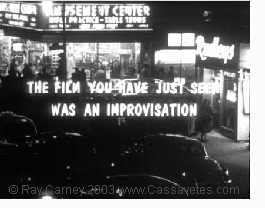|
 In
the spring of 1960, John Cassavetes was a young actor who had played
a series of undistinguished roles in a string of low-budget B-movies
and television shows. Six months later, he was being hailed as one
of the most promising directors in the world. In July, his first
film, Shadows, played to standing-room-only audiences at
the National Film Theatre’s "Beat, Square and Cool Festival."
In August, it played out of competition at the Venice Film Festival
and received a special critics’ citation. In September, it
played at a special screening at the Cinémathèque Française in Paris,
where approximately a thousand people were turned away from the
box office. In early October, it played in the London Film Festival,
to rave reviews and a sustained ovation from the audience. And a
week later, on 14 October, it opened at London’s Academy Cinema,
playing to capacity crowds and taking in more money than any film
in the theatre’s twenty-five year history. In
the spring of 1960, John Cassavetes was a young actor who had played
a series of undistinguished roles in a string of low-budget B-movies
and television shows. Six months later, he was being hailed as one
of the most promising directors in the world. In July, his first
film, Shadows, played to standing-room-only audiences at
the National Film Theatre’s "Beat, Square and Cool Festival."
In August, it played out of competition at the Venice Film Festival
and received a special critics’ citation. In September, it
played at a special screening at the Cinémathèque Française in Paris,
where approximately a thousand people were turned away from the
box office. In early October, it played in the London Film Festival,
to rave reviews and a sustained ovation from the audience. And a
week later, on 14 October, it opened at London’s Academy Cinema,
playing to capacity crowds and taking in more money than any film
in the theatre’s twenty-five year history.
Cassavetes attended
the opening with members of the cast and crew, and was over
the moon
with delight. His 16mm movie, made for $40,000 with unknown actors
(none of whom had ever played an important film role before)
was
hailed by one critic as "a major breakthrough in the
art of the cinema." Another wrote: "I unhesitatingly
pronounce Shadows
the most artistically satisfying and exciting film I have seen
in a decade." Newspapers from The Times and Observer
to the Daily Mirror and Daily Express ran laudatory
reviews, and the most important film magazine of the era, Sight
and Sound, devoted sections of three successive issues (autumn
1960, winter 1960–1, and spring 1961) to discussions of
the film and an interview with the film-maker.
What most captivated
the critics was the spontaneity and speed with which the movie
had
been made. Shadows itself ended with the declaration: "The
film you have just seen was an improvisation," and the press pack
proudly proclaimed: "Not one word of [the] dialogue was written.
Not one scene was detailed in script." It described how the crew
had "grabbed" most of the footage on New York streets: "They concealed
their camera in subway entrances, restaurant windows, the backs
of trucks." When interviewers asked Cassavetes to tell them
more, he not only bragged that the whole project had been accomplished
in forty-two days and nights, but said that it could have been
done
even more quickly if he had not occasionally had to suspend work
while his young actors went off to appear in other projects to
earn
money. He told them the sound was a little rough because it was
completely "live" — unlike a typical studio production,
nothing had been looped or "faked." Then he regaled them with stories
like the one about how the police had tried to shut down the "outlaw"
production — at one point firing a gun over the actors’ heads
to stop a scene.
What no one suspected
was that it was a pack of lies. Most of Shadows was not
shot on "location" or on the streets of New York, but on a stage.
No policeman had ever fired a gun at the actors — or over
their heads. More than half of the sound was not "live,"
but had been dubbed, looped or otherwise manipulated during the
editing
process. And, far from being a six-weeks’ wonder, Shadows
had taken almost three years to make. Finally, notwithstanding
the final title card, at least two-thirds of the film was not
an improvisation,
but was written by Cassavetes in collaboration with a professional
Hollywood screenwriter. Every one of the scenes the critics praised
in his "masterpiece of improvisation" had been scripted.
Shadows, Published
by the British Film Institute (London, England)
Distributed in America by
the University
of California Press at Berkeley
ISBN: 0-85170-835-8
88 pages; thirty illustrations
This
page only contains excerpts and selected passages from Ray Carney's
writing about Shadows. To obtain the complete text as well
as the complete texts of many pieces about Cassavetes that are not
included on the web site, click
here.
|









